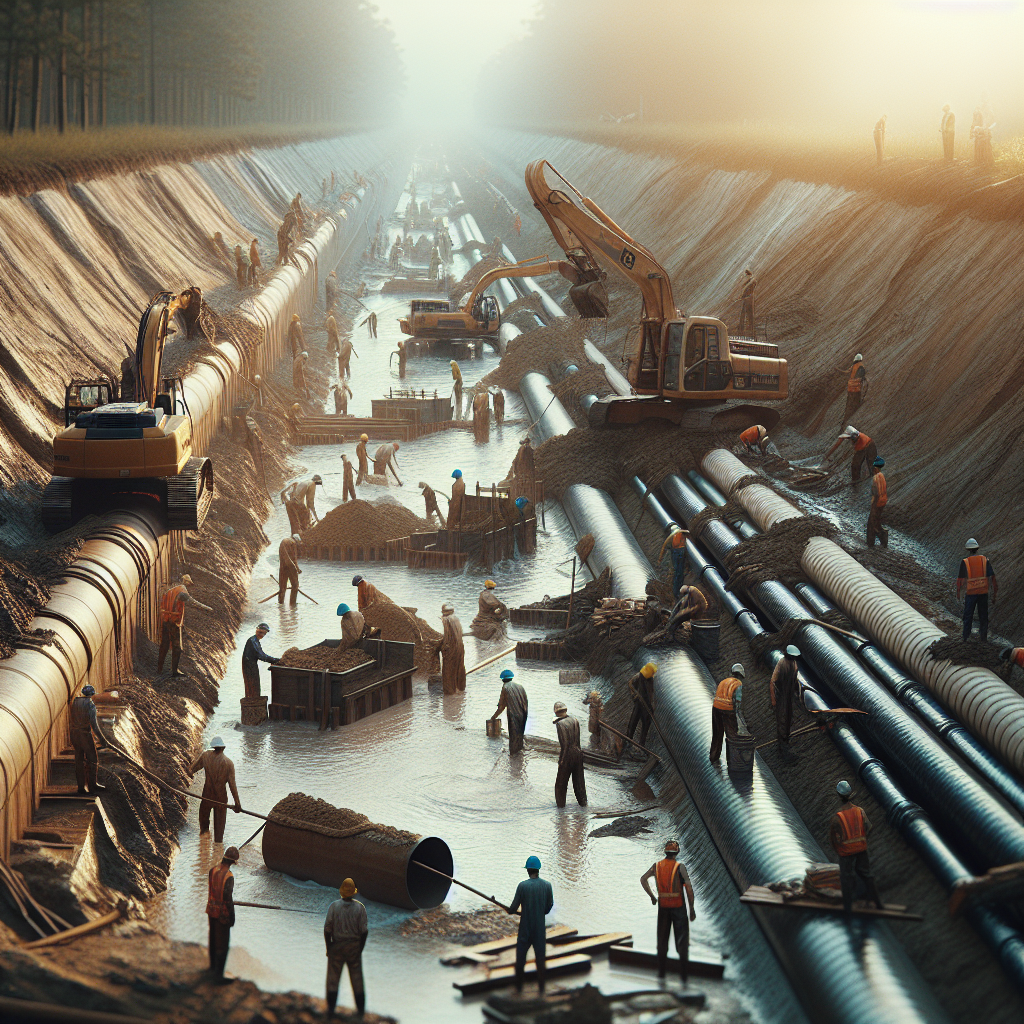An Introduction to Ditches and their Role in Construction
Have you ever noticed a long, narrow trench at a construction site and wondered about its purpose? Welcome to the fascinating world of ditches in construction. In this blog post, we’ll explore the nuts and bolts of these trenches, widely known as ‘ditches’.
We’ll explain their function in construction, how they differ in type, some important considerations when constructing them, and how essential they are in managing water flow and supporting infrastructure. We will also examine how ditches are intertwined with different aspects such as landscaping, civil engineering, agriculture, and urban development.
So, if you’ve been curious about the role ditches play in our built environment, buckle up, and let’s get started.
Understanding the Role of a Ditch in Construction
What is a Ditch?
In construction, a ditch refers to a long, narrow trench dug in the ground. It’s generally used for drainage purposes but can also serve other functions such as laying pipes or cables.
Functions of a Ditch in Construction
Ditches are fundamental to many aspects of construction. Here’s a breakdown of their primary functions:
- Drainage: Ditches help direct water away from construction sites or roads, thus preventing flooding or erosion.
- Channeling: Shallow ditches can channel water to specific areas for irrigation purposes.
- Infrastructure: Deep ditches are vital for laying underground utilities, like cables and pipes.
Types of Ditches
Different ditches serve different construction needs. Here are common types:
- Swales: Shallow, grass-lined ditches designed for rainwater management.
- Trenches: Deep ditches used for laying pipes or as footings for foundations.
- Canals: Larger ditches that serve as channels for water navigation or irrigation.
Construction Considerations
Constructing a ditch involves specific considerations to ensure effectiveness and adherence to regulations:
- Location: A ditch’s placement is critical for effective water management and minimizing environmental impact.
- Design: The design should accommodate the volume of water or utilities it will handle.
- Maintenance: Regular inspections ensure that a ditch remains clear of debris and fully functional.
Conclusion
Ditches are vital in managing water flow, supporting infrastructure, and maintaining site safety. For further reading on the significance and construction of ditches, check out this Construction News article.
Exploring Different Types of Ditches
Differentiating the Ditch Types
While the concepts of swales, trenches, and canals may be familiar, a more detailed understanding of each type could help leverage their use in construction better.
Unpacking Swales
Swales are an integral part of any landscaping project. They are shallow ditches with gently sloping sides designed to manage rainwater runoff. They are often grass-lined and serve as a green solution to redirecting water away from areas prone to flooding. This helps to
- Prevent soil erosion
- Maintain landscape aesthetics
- Control rainwater flow
Although generally used in landscaping, they are also seen in construction projects to help minimize water accumulation and prevent ground saturation.
Talking Trenches
In civil engineering and construction, the term ‘trench’ frequently occurs. It’s a type of deep, narrow ditch used for various purposes, including burying utilities such as water or gas pipes and telecommunication cables. Notably, trenches also play a key role in foundation works. They make a stable base for constructing footings necessary for load-bearing walls, helping to
- Provide reliable infrastructure
- Support structural stability
- Pave the way for utilities
Considering Canals
On a larger scale, canals are essentially vast ditches, usually lined with concrete, and filled with water for transport or irrigation purposes. Industrial canals for shipping goods are prevalent, but they also serve essential roles in agriculture as irrigation canals. They aid in
- Easing transportation
- Supporting agricultural industry
- Assisting in flood control
Additional Types of Ditches to Consider
Apart from the typical ditches mentioned earlier, other types exist for specific purposes.
V-Ditch
A V-ditch, as the name suggests, is V-shaped and frequently used in agricultural fields for soil conservation. The design allows water to flow at high velocities without causing erosion.
Furrow
A furrow is a shallow ditch used for planting crops or irrigation in agriculture.
Culverts
Culverts are structures allowing water to flow under a road, railway, or similar obstruction. They are like miniature tunnels and can be seen as a different type of ditch.
For more comprehensive information on ditches and their uses, you can refer to the resources provided by the United States Geological Survey.
Comparing Ditches and Drains
Understanding Drains
While ditches play an essential role in construction, it’s important to distinguish them from drains. Drains are constructed systems designed to remove excess surface or subsurface water from an area. They’re a vital aspect of urban development and infrastructure.
Functions of Drains
Drains are essential for effective water management, especially in urban and residential areas. Here’s how they function:
- Stormwater Management: Drains help channel rainwater away from streets and buildings, reducing the risk of flooding.
- Sanitary Waste Removal: Sewer drains transport wastewater from homes and businesses to treatment facilities.
- Prevention of Waterlogging: Subsurface drains prevent water accumulation in basements and low-lying areas.
Types of Drains
Understanding the different types of drains is key to proper urban planning and construction:
- Surface Drains: These are channels or gutters designed to collect and carry surface water away from paved areas.
- Subsurface Drains: Installed below the ground, they remove excess water from soil and prevent waterlogging.
- Sewer Drains: A network of pipes that carry sewage from homes and industrial sites to treatment plants.
Comparison of Ditches and Drains
Here is a comparison to highlight the differences between ditches and drains:
| Aspect | Ditch | Drain |
|---|---|---|
| Purpose | Primarily for channeling natural water flow and irrigation | Mainly for removing surface and subsurface water and sewage |
| Location | Frequently seen in rural and construction settings | Typically found in urban, residential, and commercial areas |
| Construction | Often dirt-lined, can be temporary | Usually constructed with materials like concrete or PVC |
| Maintenance | Requires clearing of natural debris | Needs regular cleaning of built-up waste |
Integrating Ditches and Drains
In modern infrastructure, both ditches and drains are used together to manage water effectively:
- Hybrid Systems: Combining ditches and drainpipes can enhance water management in both urban and rural settings.
- Urban Planning: Strategic placement of drains and ditches can prevent flooding and erosion, preserving infrastructure integrity.
- Environmental Impact: Proper management of both systems supports sustainability and environmental protection.
For more information on effective water management strategies involving ditches and drains, you might find this EPA resource on water infrastructure useful.
Comparing Drainage Ditches and Swales
What are Drainage Ditches?
Drainage ditches are excavated channels designed to remove excess surface water from an area. They are predominantly used in rural and agricultural settings to prevent water accumulation that can hinder plant growth and agricultural productivity. They can be shallow or deep and are often straight in design to facilitate quick water evacuation.
What are Swales?
Swales are shallow, wide channels with gentle slopes, designed primarily to manage stormwater runoff in a more sustainable manner. Unlike traditional ditches, they are often integrated into the landscape, with vegetation such as grass or shrubs lining their surfaces to help slow down and filter runoff as it moves through the swale. This process aids in recharging groundwater and enhances water quality by filtering pollutants.
Key Differences Between Ditches and Swales
To comprehensively understand how they differ, consider their characteristics:
| Aspect | Drainage Ditch | Swale |
|---|---|---|
| Primary Function | Rapidly convey water away from an area | Manage and infiltrate stormwater runoff |
| Design | Typically straight, may vary in depth | Gently sloped, shallow and often curved |
| Vegetation | Usually devoid of vegetation or minimal growth | Lined with plants for filtration and aesthetics |
| Environmental Impact | Might contribute to erosion if not well managed | Enhances groundwater recharge and reduces erosion |
| Usage Context | Agricultural and rural settings | Urban and suburban developments |
Applications and Benefits
Understanding when to use a drainage ditch versus a swale is essential:
- Agricultural Implementation: Use drainage ditches in areas where rapid water removal is necessary to safeguard crop health.
- Urban Planning: Incorporate swales in urban environments to manage stormwater sustainably, improve aesthetics, and support green infrastructure initiatives.
- Environmental Sustainability: Swales contribute to improved water quality and reduced urban heat islands, aligning with ecological goals.
Innovations and Considerations
To maximize effectiveness, both systems have specific design and maintenance requirements:
- Slope Design: Ensuring the correct gradient is vital for both drainage ditches and swales to function effectively.
- Regular Maintenance: For ditches, debris removal is essential to avoid obstruction, whereas swales require plant care and monitoring of infiltration capacity.
- Integration with Other Systems: Combining these systems with permeable pavements and rain gardens can enhance overall water management.
For a detailed exploration of swale design and uses, you might find this Green Infrastructure Wiki resource insightful.
In conclusion
Ditches are an essential component in construction and broader environmental management, serving multiple roles—from drainage and channeling to supporting vital infrastructure. Understanding the types of ditches, including swales, trenches, and canals, can optimize your construction and landscaping projects. Furthermore, it’s important to differentiate ditches from drains as they both play distinctive roles in managing water effectively in both urban and rural settings. Interestingly, leveraging the features and benefits of both ditches and drains can significantly improve our urban planning and promote sustainability. Lastly, distinguishing between drainage ditches and swales can guide us towards more strategic and sustainable water management decisions.
Frequently Asked Questions – FAQs
What is the primary function of a ditch in construction?
A ditch primarily serves drainage purposes, including directing water away from construction sites or roads to prevent flooding and erosion. It can also be used for channeling water and laying infrastructure like pipes or cables.
What is the difference between drainage ditches and swales?
Drainage ditches are typically designed for rapidly conveying water away, while swales are shallow, vegetated channels aimed at managing, slowing, and filtering stormwater runoff for environmental benefits.
How do ditches and drains differ?
Ditches are common in rural and construction settings, primarily for natural water flow and irrigation. Drains, usually found in urban and residential areas, are designed to remove surface and subsurface water and sewage.
How can ditches and drains be used together for effective water management?
Combining ditches and drains into hybrid systems can enhance water management in both urban and rural settings. Strategic placement of these systems can prevent flooding and erosion, thus preserving infrastructure integrity and promoting sustainability.






